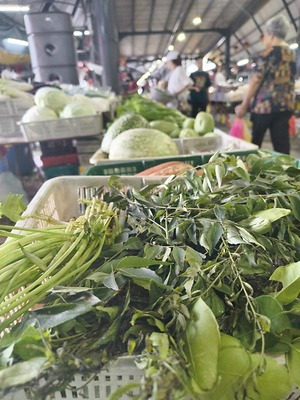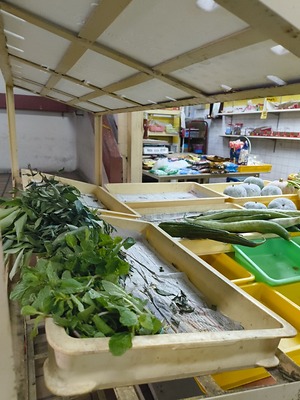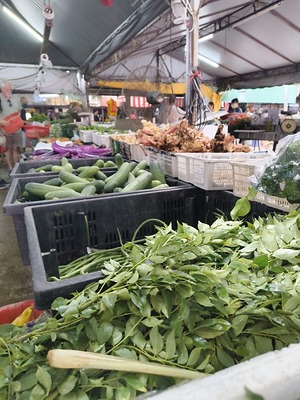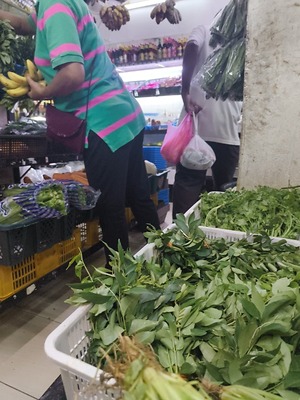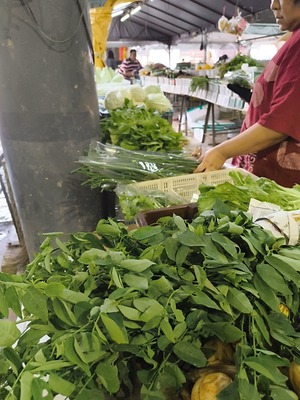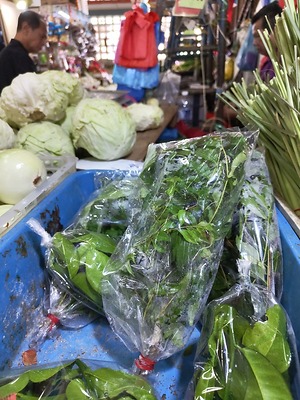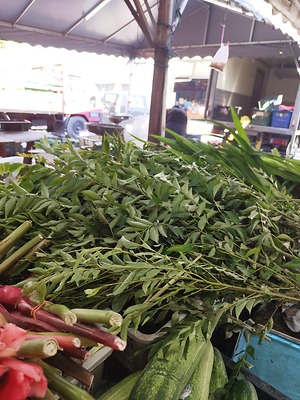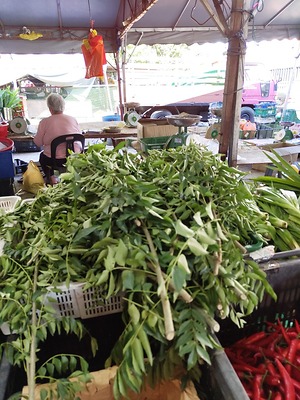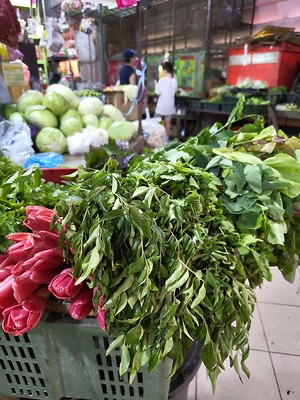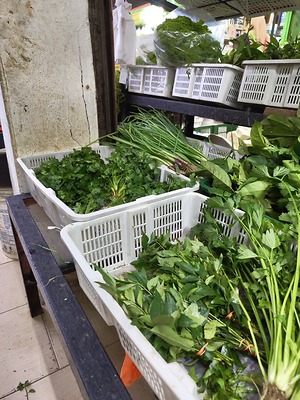

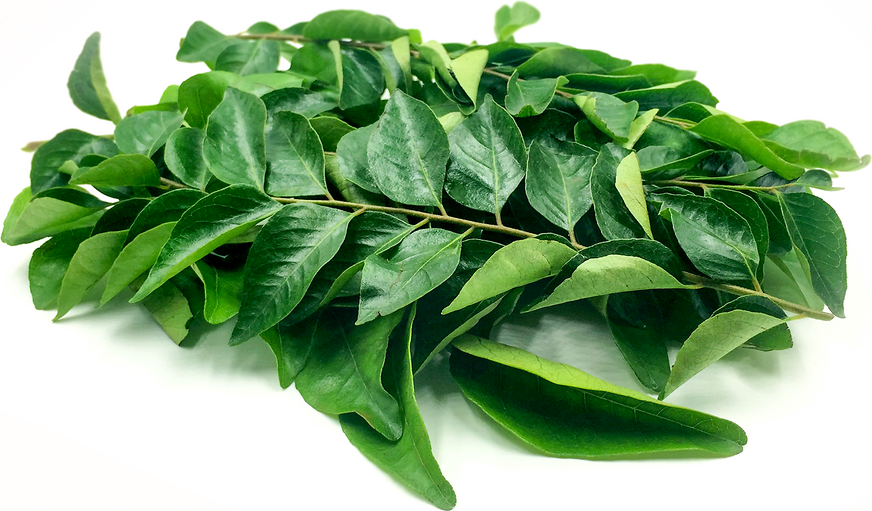
Curry Leaves
Estimated Inventory, lb : 3.98
This item was last sold on : 06/28/25
Description/Taste
Curry leaves vary in size, depending on maturity at harvest, but are generally small, averaging 2 to 4 centimeters in length and 1 to 2 centimeters in width. The leaves have a lanceolate to oval shape, tapering at both ends with a broad middle and a pointed tip. Curry leaves grow in pairs along a central stem in groupings of 11 to 21 leaves and are glossy, taut, and pliable. The dark green leaves showcase branched veining across the surface and are attached to the stems by short stalks. On the leaf’s underside, the coloring is paler and more matte. Curry leaves have smooth to serrated edges and can be tender or tough, depending on the leaf’s age when picked. Older leaves will be tougher, chewier, and more fibrous, while young leaves are tender, crisp, and only slightly chewy. Curry leaves are known for their distinct fragrance, said to have an aroma reminiscent of a blend of citrus, lemongrass, and nuts. The leaves are edible raw or cooked and have a pungent, herbal, earthy, acidic, and lightly bitter flavor with anise, asafetida, and nutty nuances.
Seasons/Availability
Fresh Curry leaves are generally harvested in the spring through fall but may be available year-round in some tropical climates. Dried or frozen leaves are also available year-round.
Current Facts
Curry leaves, botanically classified as Murraya koenigii, are an ancient Asian species belonging to the Rutaceae family. The leaves form on deciduous trees reaching 5 to 8 meters in height and are known for their memorable fragrance and flavor. Throughout history, Curry leaves have been incorporated into culinary, medicinal, religious, and cultural practices in their native growing region and have remained an essential wild and cultivated plant. Curry leaves have also expanded in commercial production worldwide as a culinary flavoring. It is important to note that Curry leaves are different from curry powder. Curry leaves are the greens picked from a tree that is either used fresh, dried, or frozen. Curry powder is a varied spice mix with herbs, seeds, and other aromatics. The word curry was a historically British invented term to generally categorize pungent or spicy ingredients. Curry is thought to have been derived from the Tamil word “Kari,” meaning “spiced sauce,” and this word was altered by the British to eventually become curry. Curry powder and Curry leaves have distinct flavorings, aromas, and uses. In India, Curry leaves are known by many regional names, including Karivempu or Karuveppilei in Tamil Nadu, Mitha Neem, Kurry Patta, and Kathnim in Hindi, Karepaku in Andhra Pradesh, Narasingha in Assam, and Karibeva in Karnataka. In the modern day, Curry leaves are used to varying degrees in cuisines around the world, but fresh leaves are most prominently seen throughout Southern and Southeastern Asia. Curry leaves are widely incorporated into an array of raw or cooked culinary preparations and can be left in the dish when the leaves are young and tender or infused and later removed if the leaves are more mature.
Nutritional Value
Curry leaves are a source of phosphorus and calcium to support bones and teeth and fiber to regulate the digestive tract. The greens also provide iron to develop the protein hemoglobin for oxygen transport through the bloodstream, zinc to aid the body in maintaining a balanced metabolism, and copper to produce red blood cells. Curry leaves contain vitamins A, C, E, and B to strengthen the immune system, maintain healthy organs, and reduce inflammation while protecting the cells against the damage caused by free radicals. In Ayurvedic medicine, Curry leaves are chosen as a medicinal ingredient for their anti-inflammatory and antimicrobial properties. The leaves are ground into a paste and applied topically to heal burns, wounds, and skin irritations or incorporated into various soaps and shampoos for healthy hair and skin. Curry leaves are also steeped in tea to lessen fevers, and the juice is mixed with lime and sugar or buttermilk as a remedy for indigestion and nausea. In India, fresh leaves are chewed to relieve hunger and aid in weight loss.
Applications
Curry leaves have a citrusy, herbal aroma and earthy, bitter flavor suited for raw and cooked preparations. Fresh Curry leaves are recommended as they have the strongest fragrance and taste. Curry leaves are edible and can be sliced or chopped when young and tender. The stems should be stripped and discarded, and only the softest parts should be used. When incorporating more mature, tougher leaves, they are typically infused into dishes, and then the leaves are picked out before serving, similar to bay leaves. Curry leaves are a versatile ingredient used in cuisines around the world. The leaves are most commonly associated with Southern Asian cooking, especially in India and Sri Lanka. Curry leaves are popularly added to curries, soups, and stews. They are also finely chopped and incorporated into chutneys, dips, and relishes or mixed into rice dishes, salads, and dals. It is customary in India to cook the leaves in ghee or oil to help release the essential oils. Once the aroma has been coaxed from the leaves, this mixture is added to dishes for an increased depth of flavoring. In addition to Southern Asia, Curry leaves are extensively used in Southeast Asian dishes, especially in regional variations of curries found in Vietnam, Thailand, Malaysia, and Singapore. The greens are also cooked into stir-fries, added to seafood dishes, chopped into pastes and sauces, or used to flavor salted egg dishes. Beyond Asian cuisine, Curry leaves are sometimes seen in vegetable-based cuisine, grilled meat dishes, fritters, stuffed into savory puff pastries, or used as a topping on focaccia. Curry leaves pair well with spices such as mustard seeds, turmeric, coriander, and cumin, aromatics including garlic, shallots, onions, ginger, and chile peppers, potatoes, eggplant, legumes, and meats such as pork, lamb, and poultry. Fresh Curry leaves will keep for 1 to 2 weeks when wrapped in paper towels and stored in a sealed container in the refrigerator. The leaves can also be frozen or dried for extended use.
Ethnic/Cultural Info
Curry leaves are an auspicious plant incorporated into rituals and ceremonies throughout Southern India. The leaves are said to represent purity, good health, and protection against negative energies. Each community within Southern India has different beliefs and cultural uses surrounding Curry leaves, but the species is frequently used in pujas or a spiritual ritual used as an act of worship. In Hindu pujas, Curry leaves are placed on altars for Lord Ganesh, the god of wisdom, good luck, and the remover of obstacles. Curry leaves are also used in wedding ceremonies such as the mangal sutra ceremony, a tradition where the groom ties a necklace around the bride’s neck to symbolize the marriage. During this ceremony, Curry leaves are sometimes used to welcome prosperity for the couple. Beyond religious practices, Curry leaves are incorporated into blessings for celebratory meals. The leaves symbolize health and vitality in India and are believed to gift well-being when used in pre-meal rituals.
Geography/History
Curry leaves are a part of Murraya koenigii, a species native to Asia that has been growing wild since ancient times. The species is thought to have origins in regions of India, Pakistan, Sri Lanka, Bangladesh, and the Andaman Islands. Curry leaves were first mentioned in Tamil texts, a language historically spoken among people groups in Southern India and Sri Lanka. These texts date back to between the 1st and 4th centuries CE, and it is said a few centuries later, additional records appeared highlighting the use of Curry leaves as a flavoring agent in culinary preparations throughout Southern India. Murraya koenigii continued to be a wild species throughout history, and over time, the species was planted in home gardens and naturalized in other regions due to human intervention and cultivation. It was also spread by migrating peoples from Southern Asia to areas of Southeast Asia, Australia, and Africa, and later, it was introduced to regions worldwide. Today, Murraya koenigii is still found growing wild in its native regions and has become an extensively cultivated plant for commercial sale. The species thrives in tropical to subtropical climates and grows naturally in forested regions from sea level to 1,655 meters in elevation. The species is also sown in home gardens as a culinary and medicinal plant. When in season, fresh Curry leaves are found in markets, supermarkets, and wholesalers worldwide.
Featured Restaurants
Restaurants currently purchasing this product as an ingredient for their menu.
| The Seabird Resort | Oceanside CA | 442-222-9505 |
| Pacific Yacht Agents | Los Angeles CA | 808-214-0970 |
| Dija Mara | Oceanside CA | 760-231-5376 |
| Noble House Hotels & Resorts | San Diego CA | 619-276-4010 |
| Leu Leu | Leucadia CA | 619-316-5807 |
| Matsu | Oceanside CA | 760-717-5899 |
| Campfire | Carlsbad CA | 760-637-5121 |
Recipe Ideas
Recipes that include Curry Leaves. One
| Lisa's Kitchen |
|
Mung and Azuki Beans with Fresh Peas and Spices |
| The Perfect Pantry |
|
Mulligatawny Soup |
| Nyonya Cooking |
|
Fried Snake Gourd |



